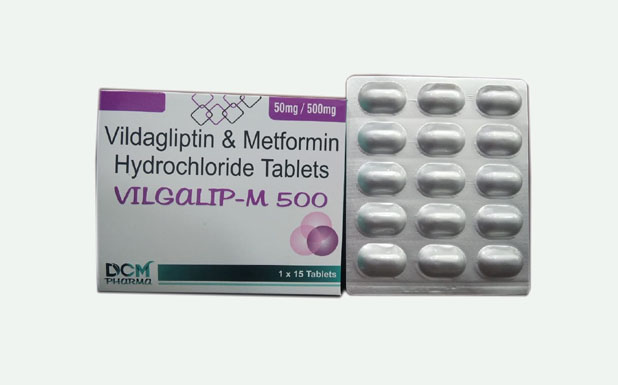Indications:It is used to treat type 2 diabetes mellitus. This condition develops if the body does not produce enough insulin , or where the insulin that your body makes does not work as well as it should . It can also develop if the body produces too much glucagon .
Mechanism of Action:It works by making the pancreas produce insulin and less glucagon ( effect of vildagliptin) and also by helping the body to make better use of the insulin it produces (effect of metformin) . Insulin is a substance whih helps to lower the level of sugar in your blood , mainly after meals. Glucagon is substance which triggers the production of sugar through the liver , which cause rise in a blood sugar. These both are made by pancreas.
Pharmacokinetics:
Vildagliptin:
Vildagliptin is rapidly absorbed with an absolute oral bioavailability of 85%. Peak plasma concentrations for vildagliptin and the area under the plasma concentration and time curve increased in dose-proportional manner over the therapeutic dose range. Following oral administration in the fasting state, vildagliptin is rapidly absorbed with peak plasma concentrations observed at 1.75 hours. Co-administration with food slightly decreases the absorption rate of vildagliptin, as characterized by a 19% peak concentrations decreases , and a delay in the time to peak plasma concentration to 2.5 hours. Although there is no change in the extent of absorption, and food does not alter the overall exposure (AUC).
Metformin:
The absolute bioavailability of metformin hydrochloride tablet which is given under fasting conditions is approximate 50 to 60%. Studies using single oral doses of metformin hydrochloride tablets 500 mg to 1,500 mg, and 850 mg to 2,550 mg, indicate that there is a lack of dose proportionality with increasing doses . Food decreases the extent and slightly delays the absorption of metformin hydrochloride, as shown by approximately a 40% lower mean peak plasma concentration (Cmax), a 25% lower area under the plasma concentration and time curve, and a 35-minute prolongation of the time to peak plasma concentration (Tmax) following administration of a single 850 mg tablet of metformin hydrochloride with food, compared to the same tablet strength administered fasting. Although the clinical relevance of these decreases is unknown.
Side Effects:
● Stomach discomfort
● Diarrhea
● Gas, bloating, vomiting
● Joint ache, headache
● Metallic taste in mouth
● Pancreatitis is somehow rare but serious side effects of vildagliptin
● Lactic acidosis is also a rare but very serious medical problem which is linked to metformin.this serious problem increases if the kidneys are not working properly.
Contraindications:
It is contraindicated in patients with Hypersensitivity , Cardiac failure (congestive heart failure requiring pharmacological treatment which may interact with metmorfin hydrochloride ) . Lactic acidosis ( It is very rare rare but it is a serious metabolic complication which occurs with acute worsening of renal function or sepsis or cardiorespiratory illness.Metformin accumulation occurs with acute worsening of renal functioning and then the risk of lactic acidosis increases).
